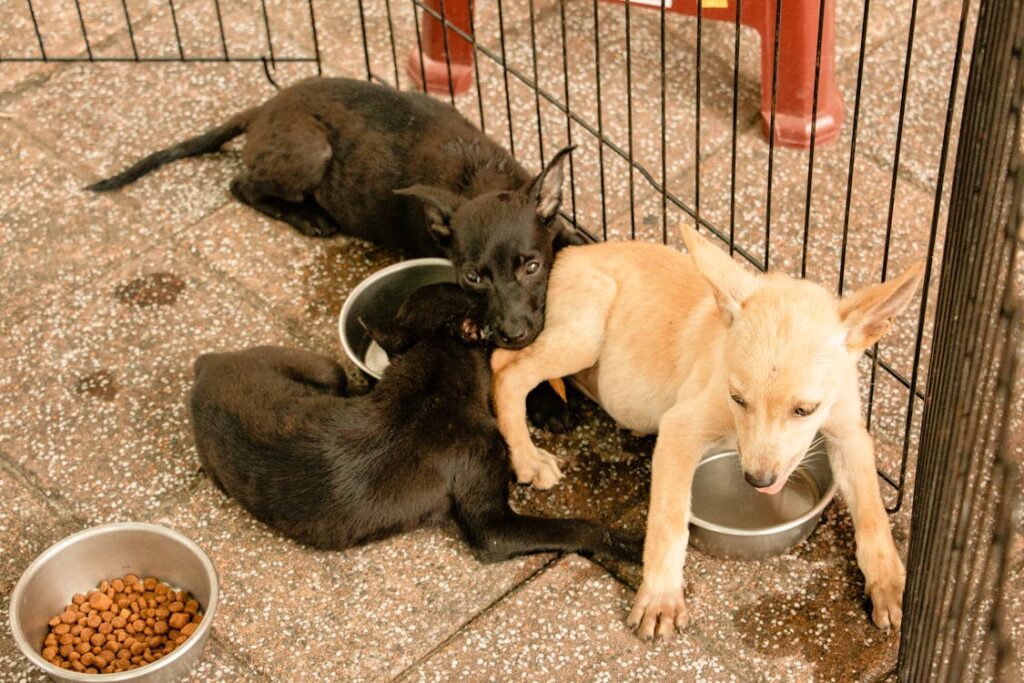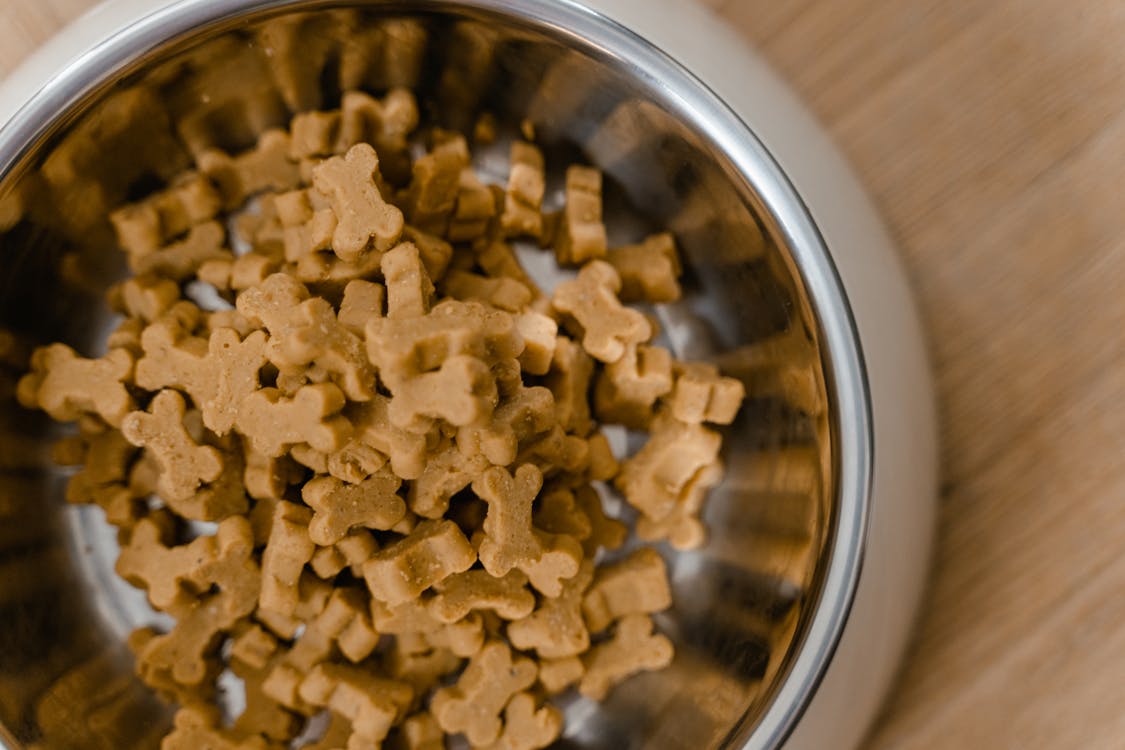In the last post we discussed about the dogs, its history and defined a best dog food, in this post we shall see details about different types of dog food
When it comes to feeding our furry friends selecting the best kind for dog foods is vital importance.
With the variety of choices that are available on the market, it can be difficult for dog owners to take a well-informed choice.
This guide will clarify the different types of pet food available, as well as their benefits and drawbacks, allowing you to choose the best option for your pet’s food preferences.
Types of Dog Food
The dog food is generally classified as below
- Dry dog food
- Wet Dog food
- Freeze Dog food
- Raw Dog food
- Diet Dog food
- Senior Dog food
- Puppy Dog food
Let us see elaborately one by one

1. Dry Dog food
Dry dog food is typically made up of bagged pellets containing 3 to 11 percent water. It is the major majority of dog food.
Dry food processing has become very popular in the food industry for pets because it’s efficient in supplying continuous feed production with a variety of varieties.
It is energy efficient, allows huge quantities in feed that can be consumed and is also cost-effective.
To create dog kibble, the process of extrusion is carried out.
An extruder is a simple device that consists of an extruder barrel and helical screw along with a die (tool for cutting and shaping food).
The feed ingredients are spongy at room temperature.
Hence extrusion of the ingredients needs an upper temperature of 150 degrees Celsius which is achieved through using steam or hot water or any other source of heat to melt or soften the mixture, allowing for flow through the barrel.
In the process of extrusion the massive levels of pressure that is applied to the mixture causes it to pass into the die and then exit the extruder completely.
After that, it is cut down to its desired size with the rotating fly knife.
However, the process of extrusion can denature some nutrients in the food.
The deficiency of taurine has been discovered in dogs who eat commercial diets that are extruded.
It is not typically considered to be an essential food ingredient to dogs.
It is abundant in all whole meats cooked or raw, but is less in diets that are extruded.
The deficiency in taurine could result from the consumption of rendered, processed meat sources which are deficient in taurine.
Whatever the reason the taurine content is being artificially added to the diet following processing during the manufacture of a large portion of industrial pet foods.
2. Wet Dog Food
The canned or wet dog food is usually packaged in a rigid and soft-sided container.
Wet food has 60-80% water, which is significantly more moist than dry or semi-moist foods.
Food that is canned is commercially sterile (cooked in the process of canning) and other wet food items are not necessarily safe to eat.
Sterilizing takes place by Retorting, which is a process that involves steam sterilization at temperatures of 121 degrees Celsius.
A particular wet food is usually higher in fat or protein as compared to a comparable dry food on an absolute basis (a measure that ignores the moisture) because of the food’s large moisture content.
A greater quantity of canned food should be fed to satisfy the dog’s requirements.
Gluten as well as other protein gels could be included in the wet food for dogs to make synthetic meaty chunks that look and feel like real meat.
The food is generally employed for dogs that are old or puppies.
Manufacturing process
Once the ingredients have been mixed and then placed in a container at the bottom of a canning machine.
From then, the mix is pushed through an opening and then onto a sheet of metal that is then formed into an 8- to 12 millimeters.
After that, the mixture is cooked to a perfect temperature, which cooks the ingredients.
Heating is done by microwaves, ovens as well as steam heating.
The sheet with the feed layer is then passed through a heat source which reflects the heat on both sides of the lower sides of the tray which allows the internal temperature to rise to the temperature of 77° Celsius at the bare minimum.
After it is cooked, the mixture can be directly put in cans to make an oblong or loaf, or it could break in “meaty” pieces for chunks and gravy formulations.
3. Freeze Dog Food
Freezer-dried meals are available in both cooked and raw forms.
They are typically air dried or frozen, and then dried (freeze-dried) to decrease the moisture level to a point at which bacteria are not able to grow.
The appearance is like dry dog pellets.
The most common feeding strategies include adding warm water prior to serving.
There are concerns about vitamin-rich nutrients, for instance loss during the process of dehydration.
Small-scale batches that are sold by online or specialty stores typically contain some type of ground meat, cooked meat, bones, pureed vegetables taurine supplements, as well as various multivitamins.
Some pet owners make use of vitamin supplements for humans, while others take vitamin supplements made for dogs.
Contents
A lot of commercial dog food is composed of ingredients that are deemed by certain pet owners and authorities to be undesirable or ineffective.
- Meat meal, bone meal and other meats
- Offal (wild canines consume offal as an essential element of their diets)
- Animal digest
- Sucrose or fructose
- Animal by-products
Cheaper dog food options generally contain less meat and a greater amount of animals’ byproducts and grains as ingredients.
Natural diet advocates are critical of the use made of these ingredients and say that laws allow packaging that can make a person think they are purchasing organic food when in fact, the food may consist of ingredients similar to the ones listed below.
Lamb meal is a very popular ingredient.
In accordance with the Association of American Feed Control Officials (AAFCO), The AAFCO states that animal by-products that are used in pet food can include components from any animal who has passed away from illness or death when they are processed in compliance with the laws.
The brains of cows and spinal cords are not permitted for consumption by humans according to federal regulations 21CFR589.2000 because of the risk of transmitting BSE are permitted to be included in food products for pets that is intended for non-ruminant livestock.
In 2003 the AVMA believed that changes could be made to the animal feed rules to restrict the consumption of certain substances that are derived from “4-D” animals – those who are regarded as dying, dead or disabled.
4. Raw Dog Food
Raw food is the act to feed pets such as domestic pets, cats and other animals with a diet that is primarily composed of raw meat that has not been cooked and edible bones and organs.
The ingredients used to create raw diets may differ.
Pet owners may choose to create their own raw diets for their pets but the commercial diets for raw foods are accessible.
Freshly prepared, frozen, meals are available in cooked or raw form and are composed of ingredients checked approved, endorsed, and certified through the USDA for humans, but are formulated for use by pets.
A major aspect of this pattern is the increasing commercialization and distribution of home-cooked pet food products for those who are looking for the same quality but don’t have the time nor the expertise to create it.
It is advantageous to avoid the traditional process pet food goes through.
This results in less damage to the nutritional value of the food.
Raw food diets has caused some concern because of the possibility of food-borne illnesses, zoonosis and nutritional imbalances.
The people who feed their dogs food that is raw have a myriad of reasons, which include but not limited to cultural beliefs, belief systems about nutrition, health and what is believed to be healthier for their pet.
Raw food consumption can be interpreted as allowing the pet to keep connected to their carnivore ancestors from the wild.
Raw food is a trend that is occurring in tandem with the shift in human food preferences to more organic and natural foods.
5. Diet Dog Food
Food for dogs that is diet-based can be a type of pet nutrition that focuses in addressing some or all nutritional concerns for your dog.
Diet dog food is designed to provide an altered, less or supplemented diet to meet the unique nutritional needs of your dog.
This may not be evident until you go to the vet regularly for a exam.
Based on the results your veterinarian discovers and what the issue is and how severe, you’ll need to alter the food your dog eats according to.
It’s crucial to be aware that the diet for healthy dogs diet that is best for your pet could differ from what’s recommended for other dogs, regardless of how similar they appear.
You should be aware however, of any family-related issues your dog could have, however it might impact your dog in a different way than their siblings or parents.
6. Senior Dog Food
Contrary to what you believe, senior dogs benefit from a high protein and low fat dog food.
We often think that as we age, dogs do not require the same amount of protein, but they actually require a high protein diet to keep the muscle mass.
However, they can prefer a low-fat diet, because they experience a decrease the amount of exercise they do as they become older.
That’s the reason why a high protein and low fat diet is ideal for dogs who are older.
The Weight Control formula is not only low in fat, however with a protein content of 25%, it’s extremely high in protein, which makes it an excellent choice to keep your dog in good shape.
7. Puppy Dog Food

One of the major differences between adult dogs and puppies is that adults consume food to sustain the body’s functions, puppies eat to expand.
Each part that they have, even bones, expands rapidly during their first year their lives (or two years if they’re large! ).
This is why the puppies are more specialized in their nutritional needs than adult dogs do.
While adult dog food isn’t likely to cause harm to your puppy, in the short-term even if they do sneak in one or two bites however, it could trigger health problems later on since it’s not designed according to puppy specifications.
Remember, puppies require an appropriate amount on nutrients they consume.
Too much can be just as dangerous as having too small! Puppy food is designed to provide the additional nutrition that the little whipper snappers require to maintain their rapidly growing bodies.
So, these are some of the different types of Dog food.
Categorize your dog and feed the dog food which they actually need.

